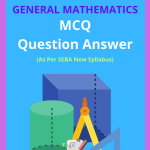SEBA Class 9 Mathematics MCQ Chapter 15 Probability Question Answer in English Medium, Class 9 General Maths Multiple Choice Question Answer in English to each chapter is provided in the list so that you can easily browse throughout different chapters SEBA Class 9 Mathematics MCQ Chapter 15 Probability Notes and select need one.
SEBA Class 9 Mathematics MCQ Chapter 15 Probability
Also, you can read the SCERT book online in these sections Solutions by Expert Teachers as per SCERT (CBSE) Book guidelines. These solutions are part of SCERT All Subject Solutions. Here we have given Assam SEBA Class 9 Mathematics MCQ Chapter 15 Probability Solutions for All Subject, You can practice these here.
Probability
Chapter – 15
| MCQ |
1. The minimum probability of an event is:
(a) 0
(b) 1
(c) 1/2
(d) -1
Ans. (a) 0
2. The maximum probability of an event is:
(a) 0
(b) 1
(c ) ½
(d) -1
Ans: (a) 0
3. What is the number of outcomes when a cubical dice is thrown?
(a) 2
(b) 4
(c) 6
(d) 3
Ans. (c) 6
4. The probability of a sure event is:
(a) 0
(b) 1
(c) -1
(d) 100
Ans. (b) 1
5. P(E) = 0.44 then P(not E) will be:
(a) 0.44
(b).55
(c) 0.50
(d) 0.56
Ans. (d) 0.56
6. The probability that a number selected at random from the number 1, 2, 3, 15 is a multiple of 4 is:
(a) 4/15
(b) 2/15
(c) 1/5
(d) 1/3
Ans. (c) 1/5
7. When a dice is thrown, the probability of getting an odd number less than 4 is:
(a) 1/6
(b) 1/3
(c) 1/2
(d) 0
Ans. (b) 1/3
8. A bag Contains 16 cards bearing number 1, 2, 3, …….. 16 respectively. One card is drawn at random. What is the probability that a number is divisible by 3?
(a) 3/16
(b) 5/16
(c) 11/16
(d) 13/16
Ans. (b) 5/16
9. The sum of all probabilities is:
(a) 0
(b) 1
(c) both a and b
(d) Lies between 1 and 0
Ans. (b) 1
10. When two dice are thrown simultaneously then total number of out comes are.
(a) 6
(b) 12
(c) 36
(d) 4
Ans. (c) 36
11. The probability of an impossible event is:
(a) more than 1
(b) less than 1
(c) 1
(d) 0
Ans. (d) 0
12. A die is thrown 300 times and odd number are obtained 153 times. Then, the probability of getting an even number is:
(a) 1/6
(b) 2/3
(c) 1/3
(d) 1/2
Ans. (c) 1/3
13. A coin is tossed 100 times and a head is got 63 times. The probability of getting a head is:
(a) 6.3
(b) 63.0
(c) 0.63
(d) 6.3
Ans: (c) 0.63
14. Two coins are thrown at the same time. Find the probability of getting both heads.
(A) ¾
(B) ¼
(C) ½
(D) 0
Ans: (B) ¼
15. A dice is thrown once. The probability of getting a number greater than 6 is-
(a) 0
(b) 1
(c) 1/6
(d) none of these
Ans. (a) 0
16. Two dice are thrown simultaneously. The probability of getting a sum of 9 is:
(a) 1/10
(b) 3/10
(c) 1/9
(d) 4/9
Ans: (C)
17. 100 cards are numbered from 1 to 100. Find the probability of getting a prime number.
(a) 3/4
(b) 27/50
(c) 1/4
(d) 29/100
Ans: (c) 1/4
18. A bag contains 5 red balls and some blue balls .If the probability of drawing a blue ball is double that of a red ball, then the number of blue balls in a bag is:
(a) 5
(b) 10
(c) 15
(d) 20
Ans: (B) 10
19. A box of 600 bulbs contains 12 defective bulbs. One bulb is taken out at random from this box. Then the probability that it is non-defective bulb is:
(a) 143/150
(b) 147/150
(c) 1/25
(d) 1/50
Ans: (b) 147/150
20. Cards marked with numbers 2 to 101 are placed in a box and mixed thoroughly. One card is drawn from this box randomly, then the probability that the number on the card is a perfect square.
(a) 9/100
(b) 1/10
(c) 3/10
(d) 19/100
Ans: (c) 3/10

Hi! my Name is Parimal Roy. I have completed my Bachelor’s degree in Philosophy (B.A.) from Silapathar General College. Currently, I am working as an HR Manager at Dev Library. It is a website that provides study materials for students from Class 3 to 12, including SCERT and NCERT notes. It also offers resources for BA, B.Com, B.Sc, and Computer Science, along with postgraduate notes. Besides study materials, the website has novels, eBooks, health and finance articles, biographies, quotes, and more.




